Canon PowerShot SX30 IS Review
Canon PowerShot SX30 IS
Canon's 35x super zoom is being touted as the biggest on the planet. Does this PowerShot show that biggest is best and truly offer the most emcompassing all-in-one solution?

Verdict
Key Specifications
- Review Price: £350.00
Though for the best image quality a digital SLR typically wins hands down at the consumer lever, attaching a whopping lens to such a device isn’t always practical nor affordable. The alternative therefore is to invest in an enthusiast targeted bridge or super zoom camera. Until recently the FujiFilm FinePix HS10 and Olympus SP-800UZ were the top dogs in the super zoom kennel, parading their ample non interchangeable 30x optical zoom lenses for all to see. 
But now there’s a new, um, dog, in town: the 14.1-megapixel Canon PowerShot SX30 IS, which, in spite of its slightly misleading model number, edges ahead by offering a 35x optical zoom. This at the time of writing makes it the world’s biggest super zoom, as least as regards the breadth of its focal range, here an equivalent 24-840mm in 35mm film terms. As you can see from our hands-on piece, it is capable of taking in the full beauty of natural landscapes and getting up close and personal for candid snapshots, it’s enough to turn any amateur snapper into a potential member of the paparazzi.
Despite a slightly plastic-y looking build, grip the SX30 IS (the suffix indicating ‘image stabilisation’ of the lens shift variety which here offers up to the equivalent of 4.5 stops) in one hand and it dispels initial worries by feeling unexpectedly rugged and is almost a match for an entry level digital SLR in terms of size and shape. With the sizeable rechargeable lithium ion battery and SD card inserted, the combined weight is 601g – a very close match for a lower end DSLR.
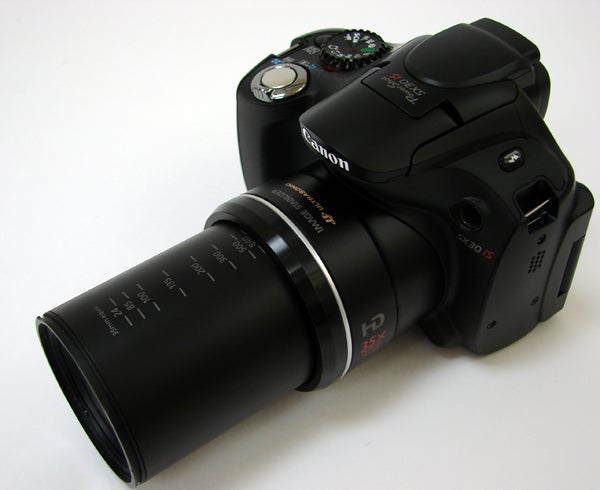
As with all super zooms – perhaps here ‘mega’ might be even more apt – the pitch is that with a focal range this broad and feature set so rich, it doesn’t matter that the lens on the front cannot be swapped as on a digital SLR. A vari-angle LCD screen also extends creative versatility by allowing the 2.7-inch 4:3 aspect ratio screen to be twisted and tilted and thus allow for those otherwise awkward-angle shots, when it’s not always possible to get on eye level with its electronic viewfinder.
Also, despite the manufacturer’s suggested retail price of a penny under £450 being a near match for the list price of a starter DSLR and standard 18-55mm zoom, to equip a DSLR with a comparable 35x lens would cost a lot, lot more – not to mention being physically impractical for most of us. Given that, the high-ish asking price starts to make more sense. Fortunately we were also able to find a more palatable street price around the £350 mark at the time of writing.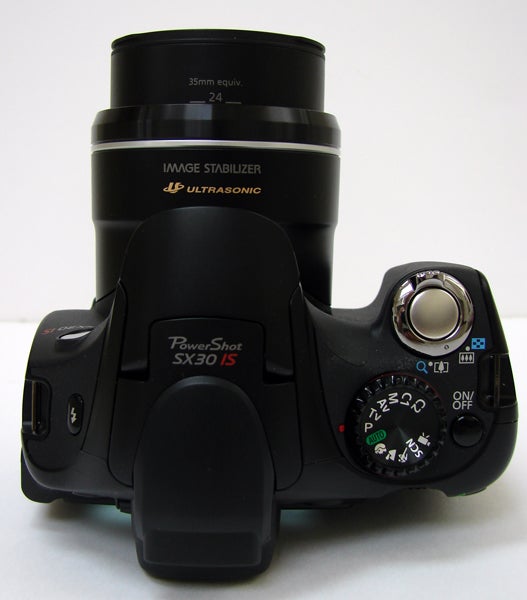
The above being said, we wouldn’t expect quality here to be on a par with a DSLR, nor is it. It may be good but it’s not that good, even if Canon does claim its lens has gone through the same rigid production processes as its EF series lenses for DSLRs.
With design cues taken from a digital SLR, the SX30 IS appears to be the same as any conventional bridge camera at first glance, once all the rage as a DSLR alternative until mirror-less compact system cameras, such as the Olympus Pens and Panasonic GF series, came along to offer a further choice.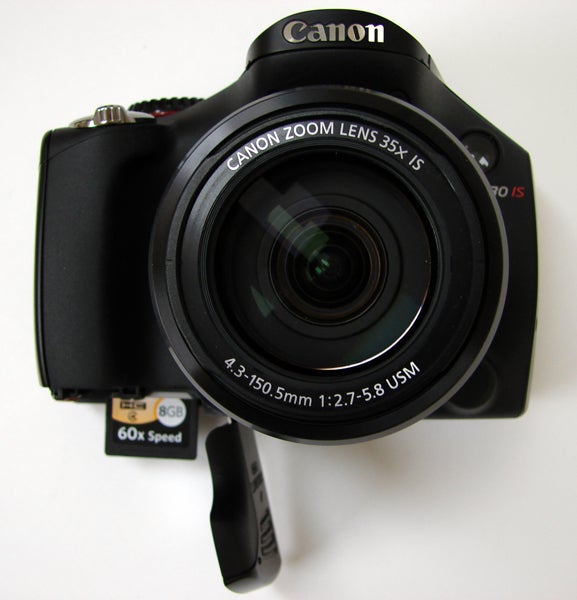
Almost everything about this camera is writ large, including the chunky shooting mode dial, shutter release button and surrounding lever for operating that whopper of a zoom. There’s even a full-size hotshoe hidden beneath a cover and set back from the pop up flash. An equally big and obvious dedicated record button for shooting video sits top right of the LCD screen, which as well as being angle adjustable can be tilted screen inward to the body for added protection when the SX30 IS isn’t in use. Rather disappointing, however, is that its screen resolution is only 230k dots, when twice that would have been more commensurate with the outlay being asked here.
We managed to fit three fingers around the Canon’s handgrip, with plenty of room between our knuckles and the lens barrel, but it disappoints slightly in not featuring rubber padding or more effective finger moulding. Our fingers tended to slip about a bit on its non roughened surface – not what’s required when you’re trying to hold the camera rock steady for a telephoto shot.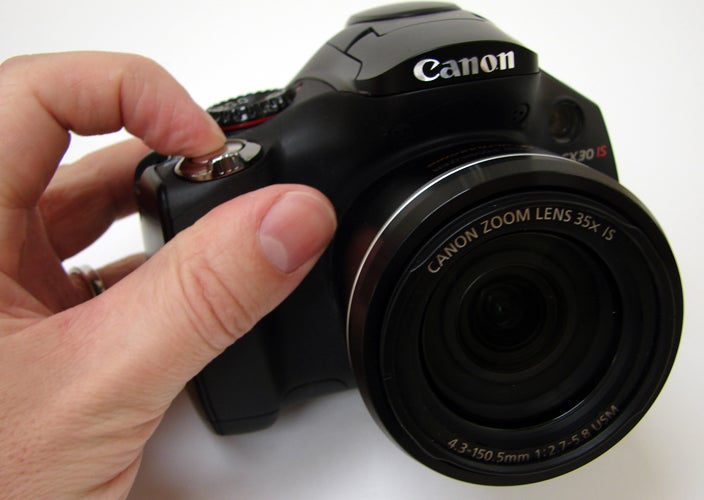
For operation that is both smooth and silent the SX30 IS’ lens has been equipped with a USM (Ultrasonic) motor, and here users can also take advantage of what Canon refers to as its Zoom Framing Assist function.
As anyone who’s tried it knows, when you’re zoomed in fully trying to track a moving subject there’s the chance it will go out of frame and you’ll have to pull back slightly to locate it again. However thanks to a dedicated shortcut button on the camera, a press of which prompts the framing to jump back to one of three preset positions, Canon has provided a time saver of sorts. Once subject is re-located and button released, the zoom jumps back to its original extended setting. We did though find ourselves accidentally hitting this control more than once, which was slightly irritating, as its location is exactly where your thumb comes to rest at the back of the camera. And, out of habit, we found ourselves more often than not just zooming in and out to re-compose the frame as necessary using the zoom lever proper.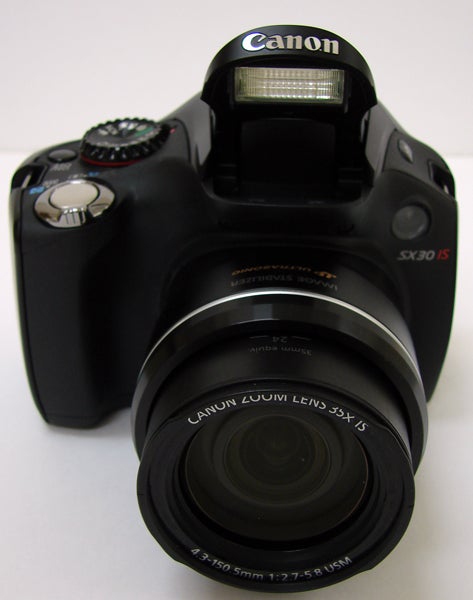
Thankfully, courtesy of that silent motor, the full extent of the optical zoom can be utilised when shooting video (as well as stills) without ruining the audio, which isn’t always the case. HDMI output is also provided under a plastic side flap alongside regular A/V and USB output, and twin stereo microphones sit unobtrusively just below the pop up flash at the front. There isn’t, however, an input for an external microphone so if the onboard ones can’t cope, you’re stuck.
Powering up in an instant, with the broadest focal range of any mega zoom on the market we can forgive the SX30 IS the odd soft shot when attempting to shoot handheld at extreme telephoto, whereon the framing does tend to float around a bit before your very eyes and it’s difficult to get composition exactly as you want it without first having two or three goes.
With roughly that number of attempts we were able to achieve commendably crisp results when shooting handheld at maximum zoom in broad daylight however, as our test shots indicate. Unsurprisingly when faced with busy scenes the camera has trouble deciding on whether it should be focusing on the background or your intended subject just in front of it, but again a couple of attempts and we got what we were after.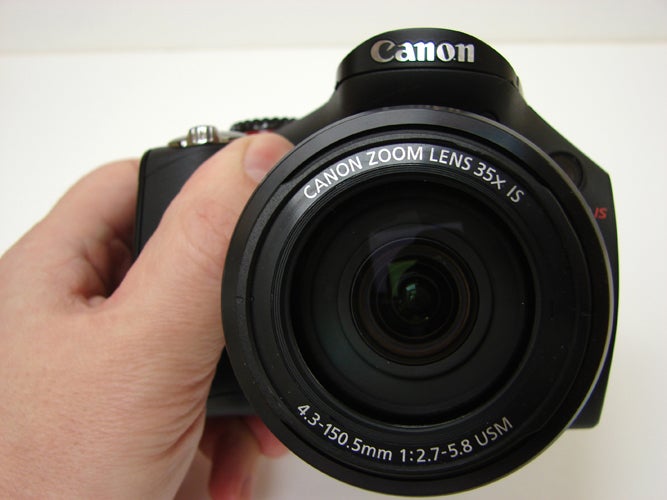
It helps that the camera is responsive. The zoom travels through its expansive range in a relatively swift three to four seconds. There is a low mechanical grinding noise as it does so, but this isn’t off-putting, especially when shooting outdoors when you’re surrounded by potentially distracting sounds anyway.
Although the SX30 IS’ LCD screen may be slightly smaller than we expected at 2.7-inches, when 3-inches and above is the norm, plus its resolution is lower than we would have liked, it does the job. There’s always the alternative of the 202k dot resolution electronic viewfinder just above, but with the LCD having the further advantage of not only being bigger but providing the ability to swivel and tilt as well – as on Canon’s equally recent EOS 60D DSLR – we didn’t find ourselves using the EVF all that often.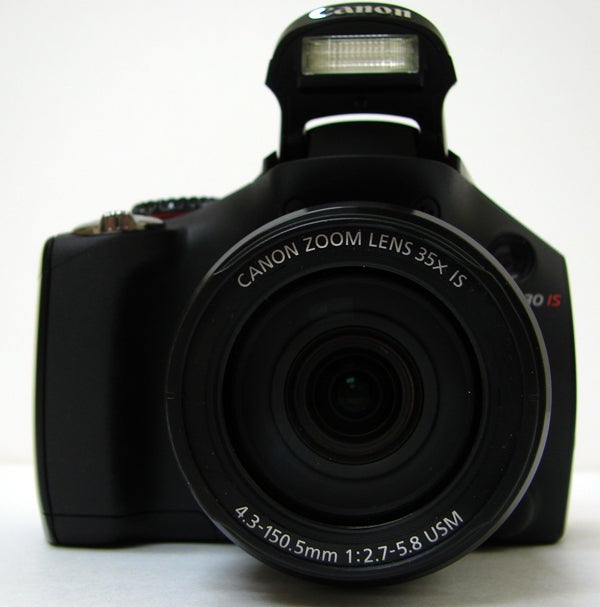
Overall when it comes to results from the SX30 IS, any grumbles we have to level at it are the usual ones. Images appear a little flat and distinctly two dimensional straight out of the camera, so require some modest tweaking for brightness and contrast at the image editing stage. Plus there is some slight (but not overly pronounced) loss of definition towards the corners of the frame when shooting at maximum wideangle. Neither are unexpected but we feel the need to be picky when this is a camera costing almost as much as a DSLR which would over much sharper and realistic results overall.
You’ll undoubtedly only be considering this camera if the versatility of an extremely broad focal range is highest on your tick list of wants. Though it doesn’t boast quite the same reach – but almost – we actually prefer the build quality and even chunkier glass offered by Fuji’s FinePix HS10, which overall we feel offers slightly better value for money too.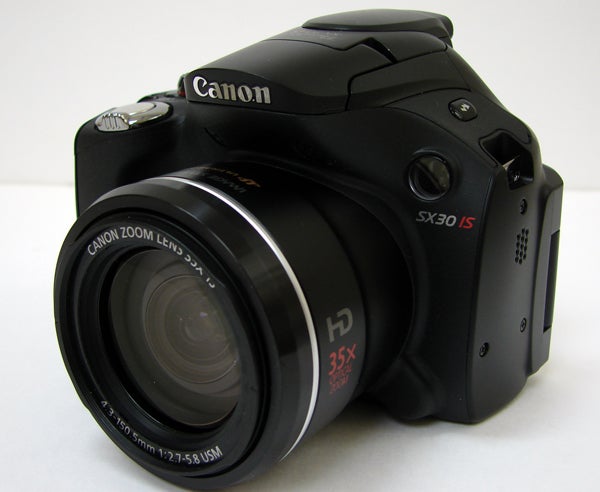
That said, there is no denying that the SX30 IS proves to be a versatile tool, allowing any number of framing and compositional combinations with its one camera, one lens set up. It’s not only easy to use, but as our test shots show, it’s also reasonably easy to achieve decent results with it too. It has obvious appeal to families, who perhaps want better pictures than their pocket snapper will deliver, but are put off by the perceived learning curve of a digital SLR or compact system camera.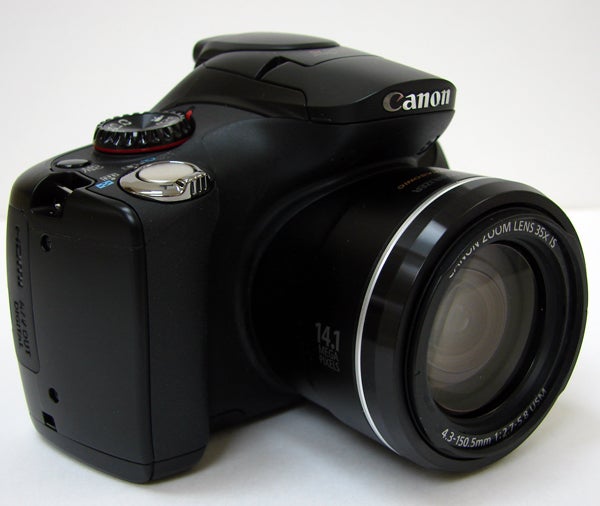
The negatives are that it costs as much as an entry level DSLR equipped with a standard kit lens, has a slight plastic-y feel that even Canon starter DSLRs have, and images tend to lack contrast and necessary visual ‘oomph’ straight out of the camera, so require a couple of minutes of tweaking to get them looking their best. If you can live with that and really do need a ‘big one’, then the SX30 IS could prove to be a solid choice for any number of applications.
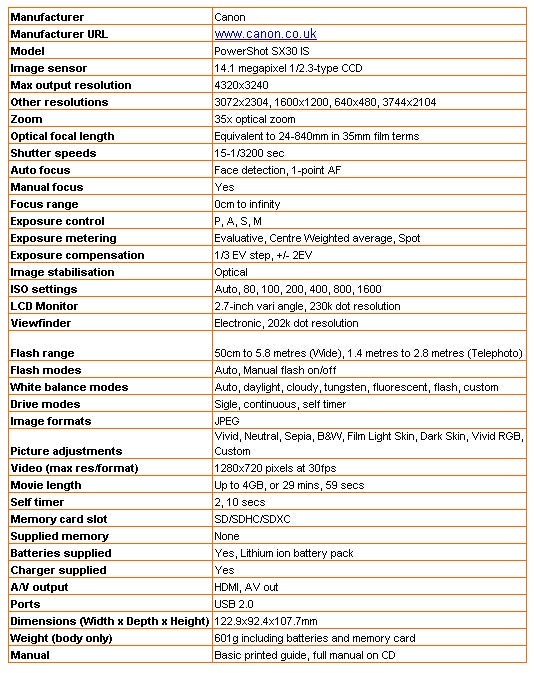
“A selection of images taken at the camera’s incremental light sensitivity settings, using only available daylight.”
—-

—-
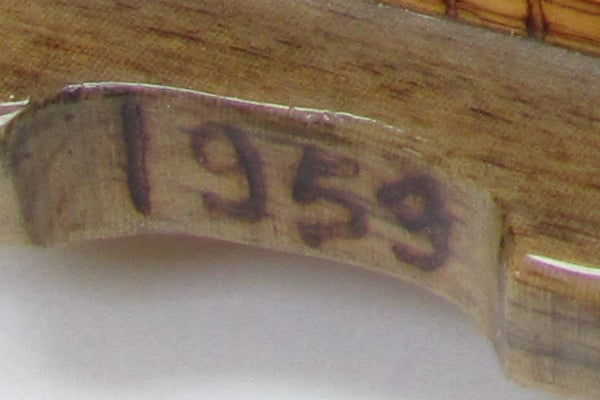
Full frame at ISO80 – starting out lower than most – and, unsurprisingly, all is well with the IXUS SX30 IS’s performance
—-

Same shot at ISO100 and no discernible difference
—-

Same lack of noise to report at ISO200, so the camera is performing as we would expect at this level
—-
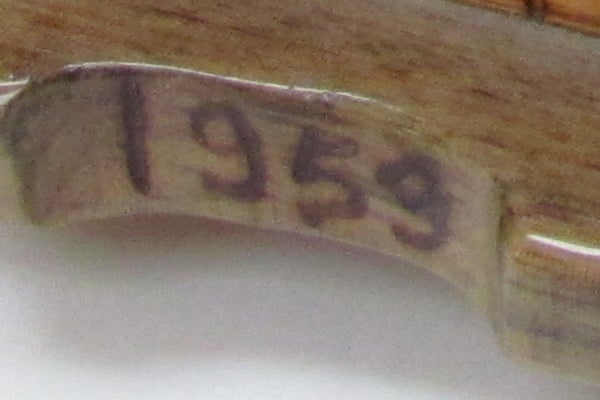
We’re at ISO400, usually the setting at which noise begins to creep in on if we’re unlucky. Here we’re just starting to lose definition in the shadow areas upon close inspection, but only very slightly so.
—-

Noise is becoming more pronounced when examining shadow detail at ISO800, but overall the image is still fairly clean
—-
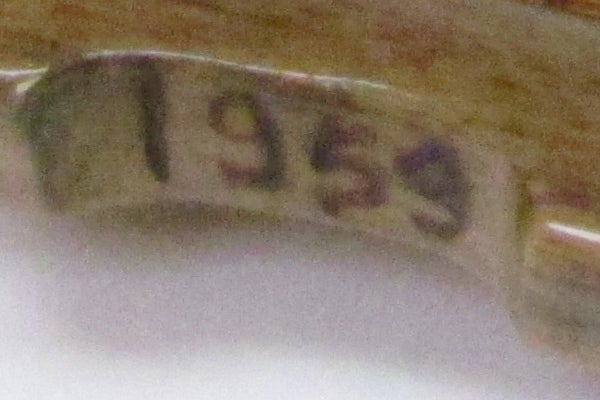
At ISO1600 we’re noticing even more softness and graining but this option has still provided a perfectly usable result, suggesting Canon was perhaps being conservative in capping its ISO here
—-
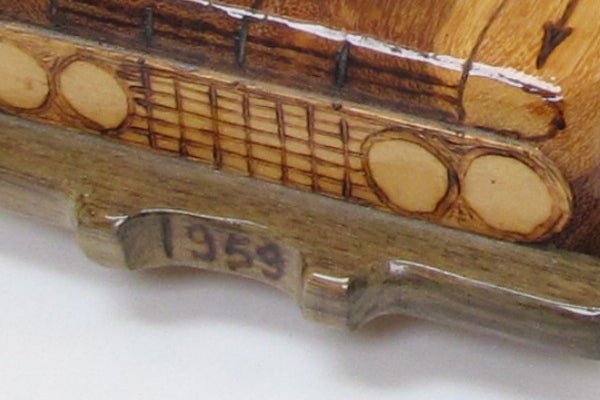
…And so we’ve tried shooting our test image with Low Light mode selected, which effects an image drop to three megapixels. Here the camera has itself chosen a setting which equates to ISO500, so again, no apparent noise.
—-

The full frame in Low light mode.
“A more general selection of unadjusted test shots are revealed on this page and next to act as an evaluation of the PowerShot SX30 IS in a variety of shooting conditions.”
—-

This wideangle shot reveals ever so subtly converging verticals, but otherwise detailing is good, plus colours and exposure are more or less spot on.
”’Full res crop”’
—-

By contrast a handheld shot from the same vantage point utilising the telephoto end of the zoom to pull the statue out from its (attractively defocused) background. Again a good level of detail, but a slightly flat image that could be given further definition with a judicious tweaking of brightness and contrast in Photoshop.
—-

Another extreme telephoto shot made all the more difficult by moving subjects and overcast conditions. But again, a degree of softness is to be expected shooting handheld at maximum zoom. We’ve lost a bit of highlight detail, but nothing we can’t live with.
—-

By contrast again, this is a wideangle macro/close up shot. The PowerShot SX30 IS allows photography as close as 0cm from your subject. Can’t get much better than that! Again, some subtle tweaks at the image editing stage would really bring out those colours further and correct for a slightly blu-ish daylight colour cast
“Here are some general test shots taken with the SX30 IS to give an idea of performance ability when it comes to image quality, dynamic range, colour rendition and the focal range of the respective optics.”
—-

This crop of an image taken at maximum telephoto zoom setting in the golden light of a late afternoon shows the richness of colour rendition achievable with the SX30 IS when conditions are in the photographer’s favour
—-

And here’s an image taken with the Canon’s miniature digital effect filter applied, which reduces the area of the image in focus to a central narrow band. You’ll also notice, if comparing this with the colours of our ISO test shots, that the overall image has been automatically warmed by the camera
—-

Generally, although we’re happy with the SX30 IS default treatment of colours, images can be a bit flat and lacking in contrast straight out of the camera, as we’ve noted. So here we’ve included an image of our wall mural before, and then after some brief Photoshop adjustment
Trusted Score
Score in detail
-
Value 7
-
Image Quality 8
Features
| Camera type | Super Zoom |
| Megapixels (Megapixel) | 14.1 Megapixel |
| Optical Zoom (Times) | 35x |
| Image Sensor | 1/2.3-type CCD |
| Optical focal length | Equivalent to 24-840mm in 35mm film terms |
| Shutter speed | 15-1/3200 sec |
| Auto focus | Face detection 1-point AF |
| Manual focus | Yes |
| Max output resolution | 4320x3240 |
| Other resolutions | 3072x2304, 1600x1200, 640x480, 3744x2104 |
| Focus range | 0cm to infinifty |
| Exposure control | P, A, S, M |
| Exposure metering | Evaluative, Centre Weighted average, Spot |
| Exposure compensation | 1/3 EV step, +/- 2EV`` |
| Image Stabilisation | Optical |
| ISO settings | Auto, 80, 100, 200, 400, 800, 1600 |
| LCD Monitor | 2.7-inch, 202k dot resolution |
| Viewfinder | None |
| Flash range | 50cm to 5.8 metres (wide), 1.4 metre to 2.8 metres (Telephoto) |
| Flash modes | Auto, Manual flash on/off |
| White balance modes | Auto, daylight, cloudy, tungsten, fluorescent, flash, custom |
| Drive modes | Single, continuous, self-timer |
| Image formats | JPEG |
| Picture adjustments | Vivid, Neutral, Sepia, Black & White, Film Light Skin, Dark Skin, Vivid RGB, Custom |
| Video (max res/format) | 1280x720 at 30fps |
| Movie length | Up to 4GB or 29 minutes, 59 secs |
| Self timer | 2, 10 secs |
| Memory card slot | SD/SDHC/SDXC |
| Supplied memory | None |
| Batteries supplied | Lithium ion pack |
| Charger supplied | Yes |
| A/V output | HDMI, AV Out |
| Charging/Computer Connection | USB 2.0 |
| HDMI | No |
| AV Out | Yes |
| Manual | Basic printed guide, full manual on CD |
Physical Specifications
| Dimensions Width (Millimeter) | 122.9mm |
| Depth (Millimeter) | 92.4mm |
| Weight (body only) (Kilogram) | 601g including battery and memory cardkg |

